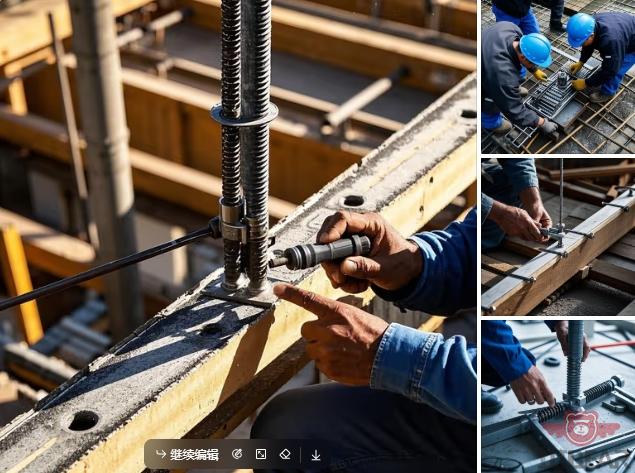Threaded rods, also known as stud bolts or all-thread rods, are versatile fasteners used in a wide range of applications, from construction and manufacturing to DIY projects. These rods feature threading along their entire length, allowing for secure connections with nuts and other threaded components. Whether you're working on a large-scale industrial project or a small home improvement task, knowing how to properly cut and install threaded rods is essential for achieving strong, reliable results.
In this guide, we’ll walk you through the process of cutting and installing threaded rods, covering everything from the tools and materials you’ll need to the best practices for ensuring precision and efficiency. Let’s dive in!

1. Understanding Threaded Rods: Materials and Specifications
Before you start cutting and installing threaded rods, it’s important to understand the materials and specifications available. Threaded rods are typically made from materials such as:
-
Carbon Steel: Commonly used for general-purpose applications due to its strength and affordability.
-
Stainless Steel: Ideal for environments where corrosion resistance is critical, such as marine or chemical industries.
-
Brass or Aluminum: Used in applications requiring non-magnetic or lightweight properties.
Threaded rods come in various diameters (e.g., 1/4", 1/2", 3/4") and thread types (e.g., UNC, UNF, metric). Always choose the right material and specifications based on your project requirements.
2. Tools and Equipment for Cutting Threaded Rods
Cutting threaded rods requires the right tools to ensure clean, precise cuts. Here’s a list of essential tools:
-
Hacksaw or Bandsaw: A manual hacksaw is suitable for small projects, while a bandsaw is ideal for cutting multiple rods quickly.
-
Threaded Rod Cutter: A specialized tool designed for cutting threaded rods without damaging the threads.
-
Angle Grinder: Equipped with a cutting wheel, this tool is perfect for heavy-duty cutting tasks.
-
Vise or Clamp: Secures the rod in place during cutting to prevent movement and ensure accuracy.
-
Deburring Tool: Used to remove sharp edges and burrs after cutting.
When using power tools, always wear safety gear, including gloves and eye protection, to prevent injuries.
3. Step-by-Step Guide to Cutting Threaded Rods
Follow these steps to cut threaded rods with precision:
-
Measure and Mark: Use a measuring tape and a marker to indicate the desired length on the rod. Double-check your measurements to avoid errors.
-
Secure the Rod: Place the rod in a vise or clamp to hold it steady during cutting.
-
Cut the Rod: Using your chosen tool (hacksaw, bandsaw, or angle grinder), carefully cut along the marked line. Apply steady pressure to ensure a clean cut.
-
Deburr the Edges: After cutting, use a deburring tool to smooth out any rough edges. This step is crucial for preventing injuries and ensuring proper threading.
-
Inspect the Cut: Check the cut end to ensure it’s straight and free of defects. If necessary, use a file to make minor adjustments.
4. Installing Threaded Rods: Best Practices
Once your threaded rods are cut to size, the next step is installation. Here’s how to do it right:
-
Choose the Right Nuts and Washers: Select nuts and washers that match the rod’s thread type and diameter. This ensures a secure fit and prevents loosening over time.
-
Drill Pilot Holes (if needed): For installations requiring anchoring into concrete or wood, drill pilot holes to guide the rod into place.
-
Use Thread Locking Compound: Apply a thread locking compound to the threads before tightening the nuts. This prevents the nuts from loosening due to vibrations.
-
Tighten with a Torque Wrench: Use a torque wrench to tighten the nuts to the manufacturer’s recommended torque specifications. Over-tightening can damage the threads, while under-tightening can lead to instability.
5. Common Applications of Threaded Rods
Threaded rods are used in a variety of applications, including:
-
Construction: Securing structural elements, such as beams and columns.
-
Manufacturing: Assembling machinery and equipment.
-
Plumbing and Electrical: Mounting pipes, conduits, and fixtures.
-
DIY Projects: Building furniture, shelving, and other custom structures.
Understanding the specific requirements of your application will help you choose the right threaded rods and installation methods.
Conclusion
Cutting and installing threaded rods may seem straightforward, but achieving precision and durability requires the right tools, materials, and techniques. By following this step-by-step guide, you can ensure that your threaded rods are cut accurately and installed securely, whether you’re working on a large-scale industrial project or a small DIY task.
To recap, we covered:
-
The materials and specifications of threaded rods.
-
The essential tools for cutting threaded rods.
-
A detailed step-by-step guide to cutting threaded rods.
-
Best practices for installing threaded rods.
-
Common applications of threaded rods.

